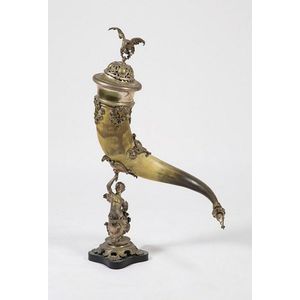Bronze Mercury on Marble Socle with Putti Frieze
You must be a subscriber, and be logged in to view price and dealer details.
Subscribe Now to view actual auction price for this item
When you subscribe, you have the option of setting the currency in which to display prices to $Au, $US, $NZ or Stg.
- Bronze - An alloy of copper and tin, traditionally in the proportions of about 9 parts of copper to 1 part of tin.
The discovery of bronze in Western Asia in the 4th century enabled people to create metal objects which were superior to those previoulsy possible because of its strength and hardness, and it has been used throughout the world for weapons, coins, tools, statuary and other decorative items.
It is very fluid in a molten state, and its hardness, strength when set, and non-corrosive properties makes it most suitable for casting sculpture. - Patination / Patina - In broad terms, patination refers to the exterior surface appearance of the timber, the effect of fading caused by exposure to sunlight and air over the course of a century or more, changing the piece to a soft, mellow colour.
As patina is very difficult to replicate, it is one of the most important guides to determining the age of furniture.
Patina is also the term applied to the bloom or film found on old bronzes due to oxidisation. - Frieze - An architectural term denoting the flat, shaped or convex horizontal surface of furniture, between the architrave and the cornice, usually found on a cabinet or bookcase, or on desks and tables where it may include drawers, the area between the top and the legs. In ceramics, the term refers to the banding, of usually a repeating pattern, on the rims of plates and vases.
- Putto / Putti / Amorino / Amorini - A putto (plural: putti) or amerino (plural: amerini) is a cherub or cupid frequently appearing in both mythological and religious paintings and sculpture, especially of the Renaissance and Baroque periods and later used as a decorative element in the design of furniture, ceramics, statuary etc. They are usually depicted as chubby males, or of indeterminate gender, often with wings. Their depiction may represent an association with love, heaven, peace or prosperity.
- Socle - The short plinth, usually cylindrical, that serves as a pedestal for a sculpture or vase
- Emblematic - Serving as a symbol.
This item has been included into following indexes:
Visually similar items

Mid-late 19th century table centre piece highland cattle horn all metal mounted on winged cherub supportive base

A Moreau French bronze cherub. Cast of a winged cherub inscribed Moreau on a circular marble base. 72 cm high

A French bronze figure of mercury, after Giambologna, 19th century, engraved mark of 'Jean de Bologne' to base, after the Renaissance original and depicting mercury posed with one foot upon a zephyr, raised on a cotton reel shaped red marble and bronze bas

A 19th century bronze figure of a 'Nude' supported on a marble socle base, impressed mark Echie bronze
